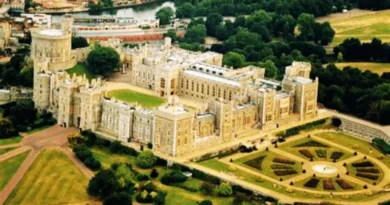How Far is Bath from Windsor Castle? Best Routes
Key Takeaways
| Category | Details |
|---|---|
| Distance | – Driving Distance: Approx. 95 miles (153 km) via M4 or M4 and A46 routes. – Straight Line Distance: Approx. 77 miles (124 km). |
| Driving Details & Routes | – Estimated Time: 1 hour 45 minutes to 2 hours, depending on traffic. – Primary Routes: M4 is the fastest; alternative route via M4 and A46. – Scenic Alternative: A more leisurely route through Marlborough and Newbury extends the journey to approximately 111 miles and can add 30-60 minutes to travel time. This scenic route offers picturesque views of the English countryside and historic towns. – Traffic Conditions: Heavy during rush hours (7-9 AM and 4-7 PM). Best to travel outside these times. – Parking: Limited near Windsor Castle, especially during peak seasons. |
| Public Transportation Options | – Train: Regular services by GWR from Bath Spa to Windsor & Eton Central, with a transfer at Reading or Slough. – Train Time: 1 hour 46 minutes to 2 hours. – Bus: National Express from Bath to London via Heathrow, then local transport to Windsor. A bus is slower and less convenient. |
| Comparing Travel Options | – Cars: Cars are the most flexible and direct but involve dealing with traffic and parking. – Train: Convenient and faster than bus, with regular services; the downside is reliance on schedules and transfers. – Bus: Cheapest but slowest and least convenient. |
| Cost Comparison | – Car: Costs include fuel, parking fees, and potential congestion charges. – Train: £40-£60 for a standard off-peak return ticket. – Bus: £15-£30 for a one-way ticket. |
| Travel Time Factors | – Influencing Factors: Weather, traffic, time of day, and tourist seasons. – Peak Season Impact: Increased travel times due to higher traffic and more crowded trains during summer and public holidays. |
| Historical Context | – Windsor Castle: The oldest and largest occupied castle, significant in British history, royal residence for over 900 years, and site of major events. – Bath: Known for its Roman baths and Georgian architecture, it is a UNESCO World Heritage Site and a cultural hub in the 18th century. |
| Pairing Bath and Windsor Castle | – Paired together in travel itineraries despite no direct historical connection, offering a comprehensive experience of English heritage from Roman times to the British monarchy. |
| Journey Planning Tips | – Travel Apps: Google Maps, Waze, National Rail Enquiries, Rome2Rio for real-time updates and planning. – Recommendations: Car travel suits families; trains are better for elderly travellers due to comfort and accessibility. |
Let’s discuss in detail:
Introduction
Bath in Somerset and Windsor Castle in Berkshire are two of England’s most iconic historical sites. Bath is renowned for its Roman baths and Georgian architecture, earning it UNESCO World Heritage status.
The city’s well-preserved Roman Baths and elegant Georgian buildings, such as the Royal Crescent and the Circus, draw visitors seeking to experience its rich heritage. Windsor Castle, the world’s oldest and largest occupied castle, has been a royal residence for over 900 years. It remains a working palace, hosting state events and attracting millions of tourists to its State Apartments, St. George’s Chapel, and the charming town of Windsor.
Understanding the distance between these two locations is crucial for travellers planning to explore both, as it aids in effective itinerary planning and selecting the most suitable transportation.
The exact Distance from Bath to Windsor Castle
Driving Distance in Miles and Kilometers
The distance between Bath and Windsor Castle is approximately 95 miles (153 kilometres) when taking the M4 route. An alternative route via the M4 and A46 also covers 95.2 miles (153.2 kilometres). These routes are the most commonly used for connecting these two locations, ensuring a direct and efficient drive.
Aerial Distance
The straight-line or aerial distance between Bath and Windsor Castle is about 77 miles (124 kilometres). This measurement represents the shortest distance between the two points, calculated as the crow flies.
However, it’s important to note that the driving distance is longer due to the road network.
Driving from Bath to Windsor Castle
Estimated Driving Time
The estimated driving time from Bath to Windsor Castle is between 1 hour 45 minutes and 2 hours, depending on traffic conditions. The M4 route is generally the fastest and most direct, but travel times can vary based on the day and any roadwork or accidents.
Primary Routes (e.g., M4, A4)
The most straightforward route from Bath to Windsor Castle is via the M4 motorway. Travellers can start on the A4 from Bath, which leads directly to the M4. This motorway is a major east-west route that connects London to South Wales, passing near Windsor. Upon reaching Junction 6 on the M4, travellers can exit and take the A332 to Windsor Castle.
The M4 combined with the A46 is an alternative option for those interested in a slightly different route. However, this route may be slightly slower despite a similar distance due to lower speed limits, more intersections, and potential traffic variations than the more direct M4 route.
Scenic Route Through Marlborough and Newbury
For travellers interested in a more scenic and leisurely drive, an alternative route extends the journey to approximately 111 miles by avoiding the direct M4 motorway. This route can take you through historic towns such as Marlborough and Newbury, offering picturesque views of the English countryside.
Although this path is less direct and can add up to 30-60 minutes to your travel time, it provides a unique opportunity to explore the rural landscapes and charming towns.
This option is ideal for those who prefer to take their time and enjoy the journey rather than simply reaching their destination as quickly as possible.

Traffic Conditions and Best Travel Times
Traffic on the M4 can be heavy, particularly during rush hours (7-9 AM and 4-7 PM) on weekdays. Areas near major urban centres such as Reading and Slough experience the most congestion. To avoid delays, it’s advisable to travel outside these peak hours or plan your journey for mid-morning or early afternoon.
Real-time traffic apps like Google Maps or Waze can help you navigate traffic more efficiently and suggest alternative routes if necessary.
Parking at Windsor Castle
Parking near Windsor Castle can be challenging, particularly during peak tourist seasons. Several parking options are available, including the Windsor Dials Car Park and King Edward VII Car Park, within walking distance of the castle. Arriving early to secure a parking spot is recommended, especially on weekends and holidays.
Public Transportation Options
By Train
Train Services Available Between Bath and Windsor:
Travelling by train from Bath to Windsor is convenient for those who prefer public transport. The journey involves taking a train from Bath Spa to Windsor & Eton Central, typically with a transfer at Reading or Slough. Great Western Railway (GWR) operates regular services on this route.
Average Journey Time:
The average journey time by train is approximately 1 hour 46 minutes to 2 hours, depending on the specific train schedules and connection times. This includes transfer time at Reading or Slough, depending on the train schedule and connection times.
Key Transfer Points (e.g., Reading or Slough):
Most trains from Bath to Windsor require a change at either Reading or Slough. Reading is a major railway hub with frequent connections to Windsor. At the same time, Slough also offers direct services to Windsor & Eton Central, making it a practical alternative based on train availability.

By Bus
Overview of Bus Services, If Applicable:
Travelling by bus from Bath to Windsor is less common but possible. National Express operates coach services between Bath and London, stopping at Heathrow. From Heathrow, travellers can take a local bus or taxi to Windsor. However, this option is generally slower and less direct than train or car travel.
Estimated Travel Time by Bus:
The travel time by bus can vary greatly, ranging from 2 to 3 hours or more, depending on the route and connections. This includes the time spent on transfers, which can add to the overall journey time.
Frequency and Convenience of Bus Travel:
Bus services are less frequent than trains and require more planning, especially for coordinating connections. The bus might be suitable for budget-conscious travellers, but it is not the most time-efficient method for this journey.
Comparing Travel Options
Pros and Cons of Each Travel Method (Car, Train, Bus)
- Car: Offers the most flexibility and directness, ideal for those wanting to explore independently. However, driving involves dealing with traffic and finding parking.
- Train: Convenient and faster than the bus, with regular services and comfortable seating. Ideal for those who prefer not to drive. The downside is the need for transfers and reliance on train schedules.
- Bus: This is the cheapest option, slowest, and least convenient, particularly for those looking to maximize their time.
Cost Comparison
- Car: Costs include fuel, parking fees, and potential congestion charges.
- Train: A standard off-peak return ticket costs around £40-£60, depending on factors like demand and booking time.
- Bus: Typically cheaper, fares ranging from £15-£30 for a one-way ticket, but the longer travel time may offset the savings.
Recommendations Based on Time, Convenience, and Budget
The train is the best option for those prioritizing time and convenience, offering a balance between speed and comfort. Driving is recommended for travellers who prefer flexibility and want to explore the surrounding areas at their own pace. The bus is suitable for budget-conscious travellers who have more time to spare.

Travel Time Variations
Factors Affecting Travel Time (Weather, Traffic, Time of Day)
Various factors can influence travel time, such as weather conditions, especially during winter when snow or heavy rain can slow down traffic or cause train delays. Traffic congestion, particularly on the M4, can increase driving times, especially during peak hours. Additionally, the time of day and season can impact travel, with summer holidays and weekends generally busier.
How Travel Time May Change During Peak Tourist Seasons
During peak tourist seasons, such as summer and major public holidays, travel times can increase due to higher traffic volumes on the roads and more crowded trains.
It’s advisable to plan your journey during off-peak times or to allow extra time if travelling during these periods.
Historical Context of Windsor Castle and Bath
Windsor Castle’s Historical Role
Windsor Castle is one of the British monarchy’s most significant and enduring symbols. Established by William the Conqueror in the 11th century, the castle has been a royal residence for over 900 years, making it the world’s oldest and largest occupied castle. Throughout its history, Windsor Castle has been a site of numerous historical events, including its use as a refuge during the English Civil War.
The castle is renowned for its architecture, which reflects various periods, from the medieval fortifications to the elaborate Gothic design of St. George’s Chapel. The chapel is particularly notable for being the spiritual home of the Order of the Garter, the most senior British chivalry order established in 1348. Additionally, it has been the venue for numerous royal weddings, including the marriage of Prince Harry and Meghan Markle in 2018.
Windsor Castle continues to play a crucial role in the life of the British royal family, hosting state visits and ceremonial events. Its State Apartments are among the finest in the world, housing a collection of artworks by masters such as Rembrandt, Rubens, and Canaletto.
Bath’s Roman and Georgian Significance

Bath’s history is equally rich, albeit different in focus. The city’s significance dates back to AD 60-70 when the Romans built a bathhouse complex around the area’s natural hot springs. These baths were dedicated to the goddess Sulis Minerva, a deity revered for her healing powers. The Roman Baths remain one of the best-preserved examples of Roman architecture in the UK, attracting millions of visitors annually.
During the 18th century, Bath underwent a transformation that cemented its status as a fashionable spa town. This period saw the construction of the city’s iconic Georgian architecture, including the Royal Crescent, the Circus, and the Assembly Rooms. The city’s popularity soared as the wealthy elite of British society flocked to Bath to “take the waters,” believing in their medicinal properties. This era also saw the rise of social activities such as balls and concerts, making Bath a cultural hub during the Georgian period.
Today, Bath is a UNESCO World Heritage Site, recognized for its Roman remains, Georgian architecture, and the cultural influence it wielded in the 18th century.
The city’s historical importance is reflected in its preservation efforts and the continued popularity of the Roman Baths as a tourist attraction.
Why These Locations Are Commonly Paired in Tours
While Windsor Castle and Bath do not have a direct historical connection, they are often featured together in travel itineraries and tours due to their complementary roles in showcasing different aspects of England’s rich heritage. Windsor Castle represents the enduring legacy of the British monarchy and offers a deep dive into the country’s royal history. In contrast, Bath provides a window into Roman Britain and the height of Georgian elegance.
For travellers seeking to understand the broad spectrum of English history, a visit to both Windsor Castle and Bath offers a comprehensive experience, spanning from the ancient Roman era to the ongoing legacy of the British royal family. This combination allows visitors to explore two different yet equally significant facets of British culture and history in one trip.
Tips for Planning Your Journey
Real-Time Traffic and Travel Apps
When planning your journey from Bath to Windsor Castle, several tools and apps can help ensure a smooth trip:
- Google Maps: This app provides real-time traffic updates, estimated travel times, and suggested driving and public transportation routes. It also offers alternative routes in case of traffic jams or road closures.
- Waze: A community-driven app that offers real-time updates on traffic, road hazards, and police sightings. It’s particularly useful for avoiding traffic congestion and finding the quickest routes.
- National Rail Enquiries: Essential for those travelling by train, this app provides up-to-date information on train schedules, delays, and platform numbers. It also offers options for purchasing tickets directly through the app.
- Rome2Rio: A comprehensive tool that compares different modes of transportation, providing detailed route options, including combinations of car, train, and bus travel.
Advice for Families, Elderly, and Other Needs
- Families: Traveling by car may be the most convenient option, offering flexibility and the ability to stop as needed. If using public transportation, trains are generally more comfortable and spacious, with amenities such as restrooms and food services on board. Be sure to check for family discounts on train tickets.
- Elderly Travellers: The train is an excellent option for elderly travellers, providing a smooth and comfortable journey without the stress of driving. Many trains have priority seating, accessible toilets, and onboard assistance. If driving, consider planning for frequent stops to rest and stretch.
Summary
The journey from Bath to Windsor Castle is a physical trip and a voyage through time, exploring some of the most significant aspects of England’s heritage. Whether you choose to drive, take the train, or use a bus, each mode of transportation has its benefits depending on your time, convenience, and budget.
This article accurately assesses the distance and travel options between Bath and Windsor Castle, corrected to reflect the most up-to-date information. Additionally, it delves into the historical significance of both locations and why they are often visited together despite no direct connection.
Whether planning a day trip or a more extended exploration of these historic sites, understanding the logistics and historical contexts will enrich your travel experience. With the right tools and planning, your journey between these iconic English landmarks will be as smooth and enjoyable as possible.
FAQ
What is the driving distance from Windsor Castle to Bath?
The journey spans approximately 95 miles (153 km) via the M4 motorway, making it a manageable drive for a day trip or weekend getaway.
How long does it take to drive from Windsor Castle to Bath?
Under normal traffic conditions, the drive takes about 1 hour and 45 minutes to 2 hours. However, this can extend during peak times, such as weekday mornings and evenings, due to increased traffic.
Is there a scenic driving route from Windsor Castle to Bath?
Yes, an alternative route through Marlborough and Newbury covers around 111 miles. This path offers charming views of the English countryside and historic towns but adds 30 to 60 minutes to your journey.
What are the public transport options from Windsor Castle to Bath?
You can take a train from Windsor & Eton Central to Bath Spa, typically requiring transfers at Reading and Slough. Services are operated by Great Western Railway (GWR).
How long is the train journey from Windsor to Bath?
The train journey usually lasts between 1 hour and 46 minutes to 2 hours, depending on connection times and transfer efficiency.
Are there direct trains from Windsor to Bath?
No, direct trains are unavailable. Passengers must generally change trains at Reading and Slough to reach Bath Spa.
How frequent are the train services between Windsor and Bath?
Trains run regularly throughout the day. It’s best to consult the GWR timetable or use real-time journey planners for precise schedules.
What is the cost of a train ticket from Windsor to Bath?
Ticket prices vary based on booking time and travel class. Booking in advance can secure fares starting from £20.50. Check the GWR website or authorized ticket vendors for current prices and potential discounts.
Is there a bus service from Windsor to Bath?
Direct bus services are limited. National Express operates routes from Windsor to Bath via London or Heathrow, but these journeys are longer and may require multiple transfers.
Can I visit both Windsor Castle and Bath in a single day?
While feasible, visiting both in one day is ambitious due to travel times and the wealth of attractions at each site. To fully appreciate both destinations, consider allocating a full day to each.
Are there guided tours that include both Windsor Castle and Bath?
Some tour operators offer combined day trips from London covering both Windsor Castle and Bath. However, these tours can be hurried, providing limited time at each location.
What are the parking options in Bath for visitors driving from Windsor?
Bath offers several public car parks and park-and-ride facilities. However, parking can be scarce during peak tourist seasons, so arriving early or using park-and-ride services is advisable.
Is it advisable to book train tickets from Windsor to Bath in advance?
Yes, booking in advance often results in better fares and ensures seat availability, especially during peak travel periods.
What attractions can I visit in Bath after travelling from Windsor Castle?
Bath boasts numerous attractions, including the Roman Baths, Bath Abbey, the Royal Crescent, and the Jane Austen Centre, each offering unique insights into the city’s rich history and culture.
Are there any notable stops between Windsor and Bath worth visiting?
Yes, notable stops include Stonehenge, a prehistoric monument, and the town of Marlborough, known for its historic architecture and vibrant high street.









